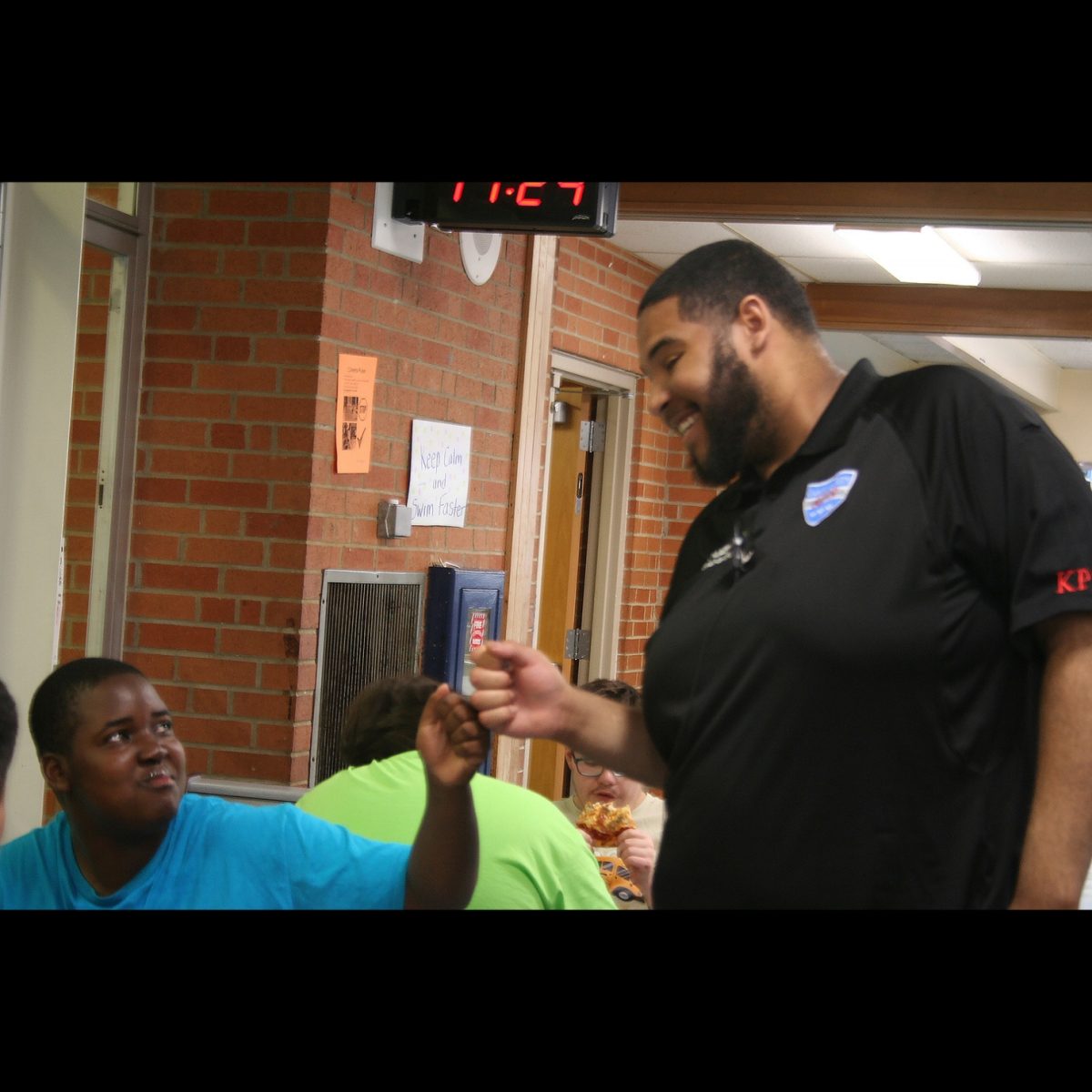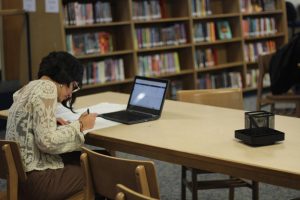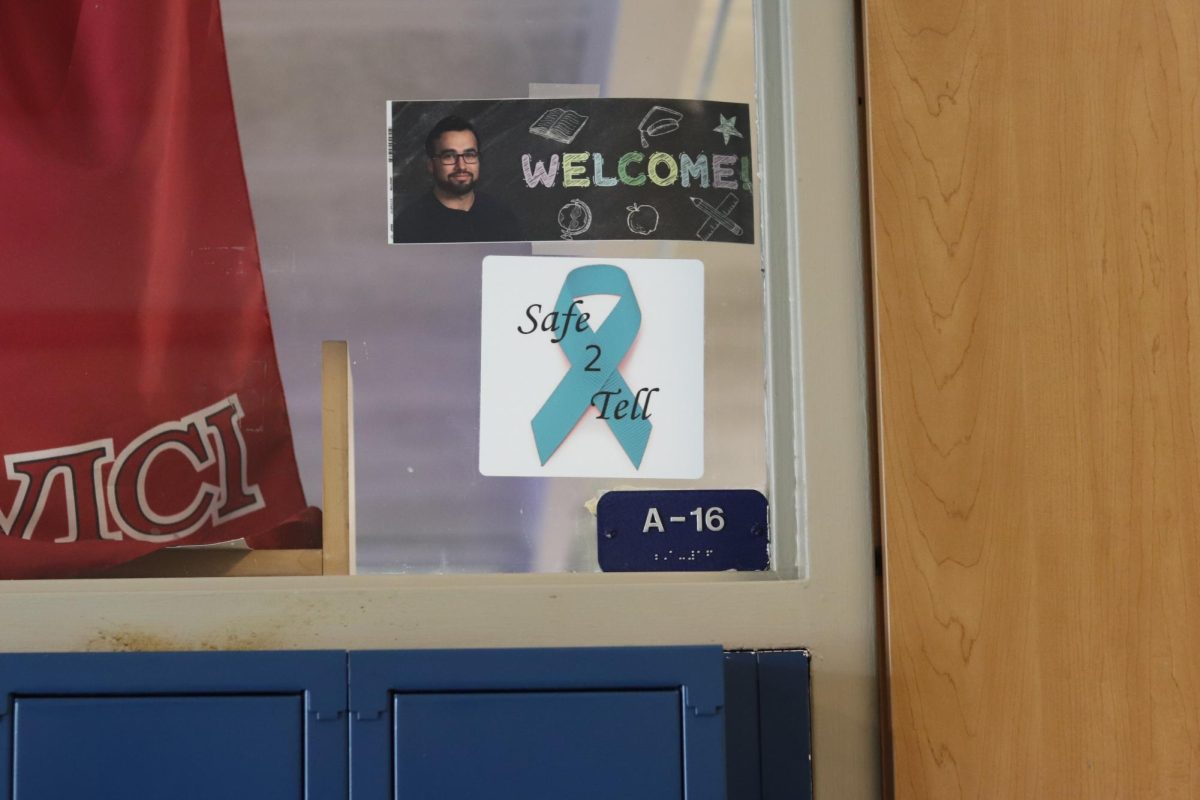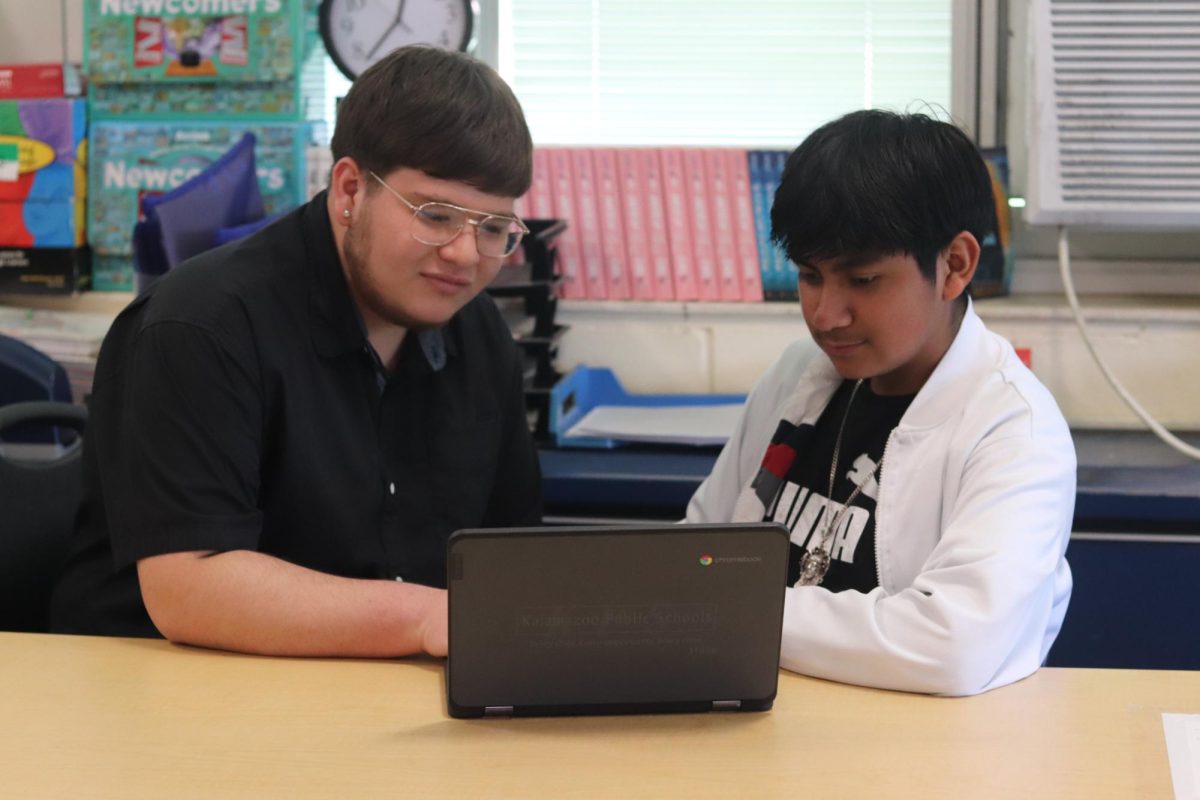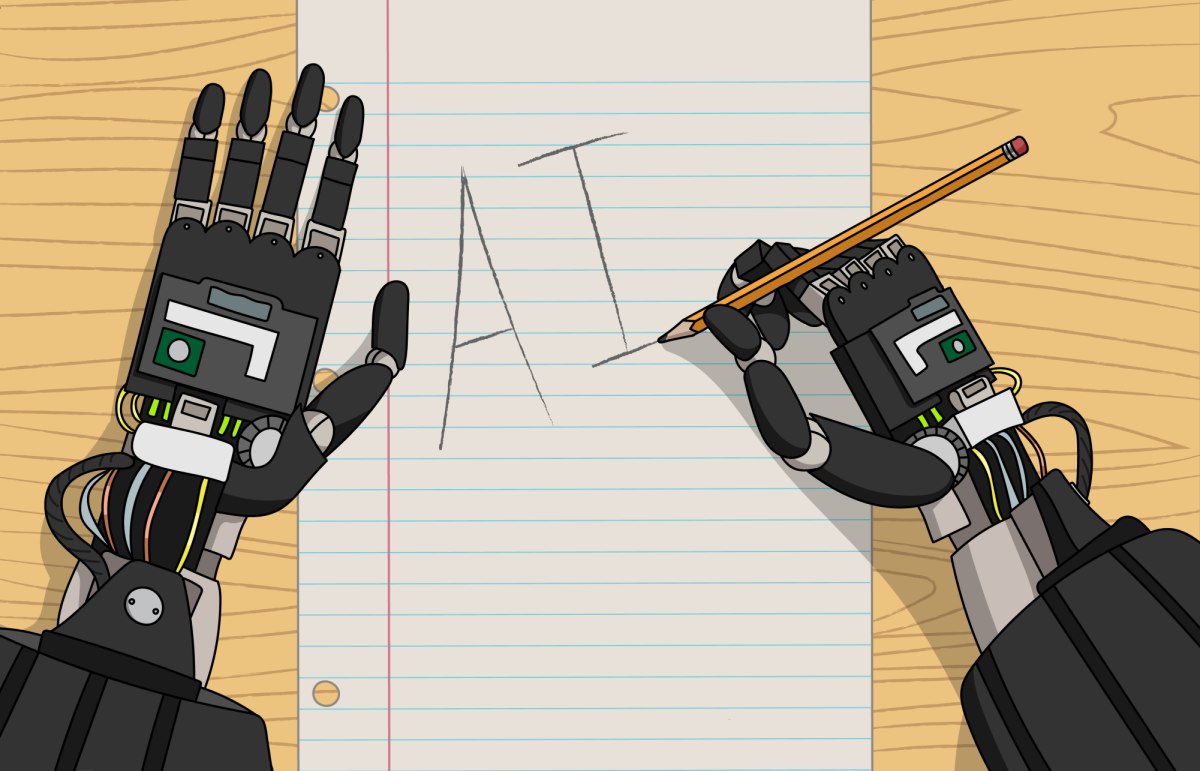More student representation in KPS would allow for more progress in the district
Credit: Christopher Aguinaga
The Loy Norrix Student Senate poses for a photo with Principal Christopher Aguinaga and former Superintendent Rita Raichoudhuri. The Senate had a few opportunities to meet with leaders in the district and Aguinaga is a chair on the Student Senate himself.
May 25, 2023
On Wednesday, March 15, there was a forum for students to answer questions about what they want to see in their future superintendent. When asked “What qualities would you most like to see in the new superintendent?” answers overwhelmingly had to do with the ability to listen to student voices and incorporate them into decision making.
According to Consider Student Voices: Striving to Understand Student Experiences to Support Learning and Growth, published by the Regional Educational Laboratory, “Researchers show that students as young as nine years old (grades 3 or 4) can begin to separate themselves from adults and provide meaningful feedback on their education.”
The superintendent forum in March was entirely student-based and the first of its kind. This inclusion was valued by the students who attended, and each question students were asked was met with insightful answers that could only have come from the kids who were living, working and playing within the walls of Loy Norrix. The forum showed the unique views that students have on their education and made clear the need for forums like this on a larger, more consistent basis.
At Norrix, there are ways that student voices are incorporated into school decision making, but the scale is small. The Loy Norrix Student Senate has 23 students from different grade levels. The group meets monthly to discuss various insights that the student body has regarding Loy Norrix with Principal Christopher Aguinaga.
Student Senate has evolved significantly since the pandemic. Prior to 2020, students within the governing body were selected using teacher recommendations, meaning this year’s seniors were selected this way. This year’s sophomores and juniors, however, were selected in a more democratic manner with teacher recommendations and then a student vote. This is likely how elections will proceed for incoming senators.
Very few student-voice programs are as influential as the Student Senate is. But when discussing its makeup, an important issue arises: the Student Senate is an extremely small portion of the student body, around 1.3%.
“One thing that I always envision more for Student Senate is more student body participation rather than us just bringing what we [current Student Senate members] know are concerns,” said Amady Mboup, senior and chair of the Student Senate.
There is no way to properly gauge student opinion with such a small group of students. In an ideal world, the administration would be able to hear how every student feels on any given issue and be able to take each of those responses into consideration.
“I feel like our voices are being heard, and I feel like we are having a direct line of communication to Aguinaga,” said senior member Yacine Lo, “but I think there’s plenty of people around the school who would extremely benefit from having that sort of space and we don’t have it [a place for large groups of students to have a direct line of communication with Aguinaga].”
Making school administrators hear the opinions of every single student is unrealistic, but getting as close as possible to that outcome would provide a more diverse array of student opinions, and the general opinions of the larger student body would be showcased.
A solution to this could come in the form of greater student discourse with those in the Student Senate. In order to hear the diverse opinions of the student body, there could be a way for students in the senate to gather the opinions of the greater student population. For example, a suggestion box or a regular poll.
An additional obstacle arises when considering how small the Student Senate is: lack of student body representation, which could also begin to be solved by the implementation of surveys or polls.
According to the Center for American Progress’s Elevating Student Voice in Education report, one of the downsides to student governing bodies in schools is that those students who are included in the group are often those “for whom the current education structure is already working.”
There is a greater chance for marginalized students who are negatively affected by current education policies to be included in these bodies if they are actively sought out or if the group is larger and more inclusive. The only way for there to be productive conversations surrounding ineffective education structures is by including students who are actively being failed by the policies in place around them. If conversations are being had without them present, then there is a possibility for insufficient solutions being made.
“They can’t be for us, without us,” freshman Paul Evans quoted.
When Student Senate did a survey drive in March of 2023, they surveyed students through email and in person in order to get responses from a group that was more representative of the student body as a whole.
“What the senators found as they analyzed the survey results was that the online responses were overwhelmingly done by Caucasian students, so they were intentional with the paper survey to target underrepresented groups so that the results would be more beneficial,” said Aguinaga.
“An overwhelming theme was that students had negative views regarding the climate and culture of Loy Norrix, so we can’t hide that and now the senate is actively working to try to fix that or make it better,” Aguinaga said.
As seen by the results of the March survey drive and the steps that Student Senate is taking to resolve some of the issues that came to light, surveys are extremely beneficial and implementing them on a more consistent basis would help make up for the fact that the group is a small proportion of students.
Student Senate also has students who sit in on the KPS Equity Task Force as well as school improvement meetings.
“[Leadership and school improvement meetings] typically have been meetings where adults make decisions about changing operations here at the high school for better outcomes for kids, but we were missing student voice,” Aguinaga said.
This recognition is vital for the further consideration of student voices within school decision-making, and while Aguinaga and Norrix administrators see this as a necessity, the KPS district as a whole seems to fall behind.
“I think that KPS is kind of definitely lacking in student representation once you get to the more administrative positions,” said Yacine Lo.
There are a lot of issues currently permeating the KPS district and incorporating student voices into district-wide bodies, like the KPS school board, could help the district focus on the problems that students actually care about.
According to the Center for Disease Control and Prevention, “Youth Advisory Boards foster partnerships between youth and adults, give youth an opportunity to make positive change in their schools and communities and build important leadership skills among youth.”
KPS has a parent advisory board, but the only way for students to have their voices heard is during school board meetings where they can speak.
In order to speak at board meetings the Board of Education’s policy states that a sign-in sheet must be filled out and speakers have three minutes each to speak. They “may not address confidential student or personnel manners” and are also encouraged to submit a written form of their comments.
“At board meetings, youth will come up and address the board, so I definitely think we need more youth voices there because it’s important to have a voice,” Evans said.
Evans makes a good point, but some students have personalities or preferences that prevent them from going up and speaking at a board meeting. Offering a controlled environment, like an advisory board, where student voice is the focal point may encourage more participation from students who are otherwise silent.
An advisory board on the district level would also offer direct communication with the people who are at the forefront of decision making: district administrators and school board officials.
“That’s been one of the most internal and external criticisms of Student Senate: that it’s a lot discussion based,” Lo said. “There’s just so much that goes into being able to actually enact change that a lot of times we spend our meetings talking about how can we even begin to address the issues.”
The more direct contact students have with the district, the more up-front information they can be given about how issues can actually be solved. An advisory board would also promote the district and administrators to be clear with students about why the issue is there and the possibilities, if any, for resolution.
If student voices are being considered, they must be heard on a variety of topics, not just those that people in power are comfortable with. Student voice implementation is only performative if their opinions are only considered on certain issues.
“I think that there are ways in which a lot of the higher-up [student] roles we have among the student body are vanity based and less actually action driven,” said Lo.
In her doctoral dissertation titled, Student voice in education policy: Understanding student participation in state-level K–12 education policy-making, Samantha Holquist writes, “Adults, such as educators and policymakers, working with student voice effort must diminish their positional power to enable students to participate in decision making in a greater capacity.”
The voices of students when it comes to their education and community are invaluable. They are at the forefront of reform and are directly impacted by changes made within the district, regarding their education. They can offer unique insight into problems and solutions that the adults making the decisions can not.
“[Students offer] a different perspective: when planning something in school or outside school, youth definitely have a better eye for what other youth like rather than adults because they grew up in different generations,” Evans said.
The benefits of including student voices in decision making expand beyond the decisions themselves. By including students in these conversations, they begin to care more because they actually have a stake in their education.
In a case study carried out by the Center for American Progress, Pittsfield Middle High School in New Hampshire implemented student voice programs and initiatives and found that “Pittsfield Middle High School’s dropout rate has decreased by more than half, from 3.9 percent in the 2010-2011 school year to just 0.6 percent in the 2016-2017 school year.”
In the 2020-2021 school year Norrix had a graduation rate of only 80%. The inclusion of student opinion in their own education could help address this concern.
Implementing intentional, action-based, diverse student voice initiatives on both small and large scale throughout KPS that actually impact decision making and education policy is a necessity for the success of the district and increased student engagement.
On a smaller, school-wide basis, more student opinions must be considered and advisory for administrators should be expanded. When it comes to the district as a whole, a new superintendent must come with increased student voice initiatives on the district level, whether that be through a youth advisory board or greater encouragement of student speakers at board meetings.



